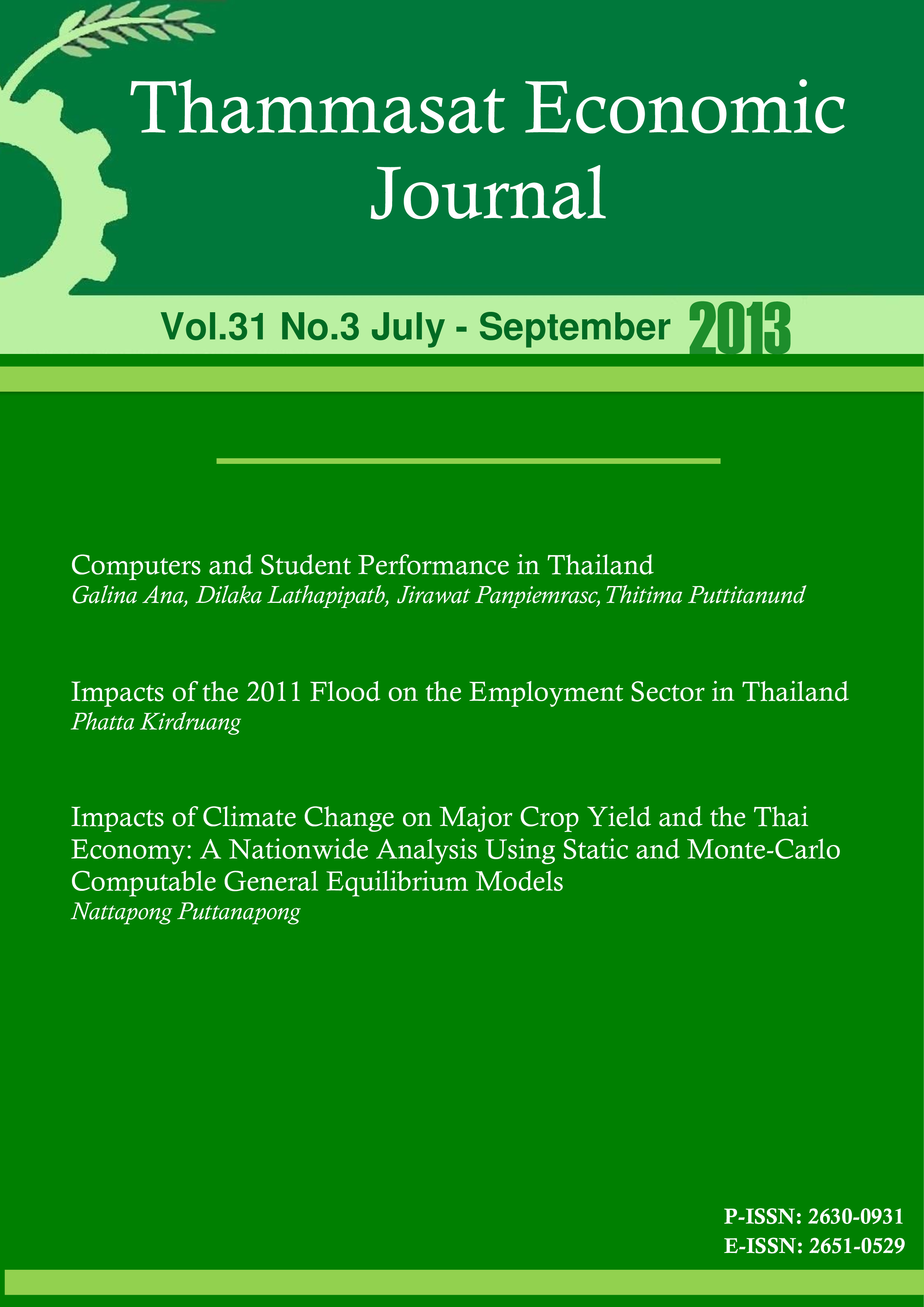Impacts of the 2011 Flood on the Employment Sector in Thailand
Keywords:
Labor Market, Earnings, Employment, Difference-in-DifferenceAbstract
This study seeks to examine the short-term impacts of the 2011 flood on the labor market outcomes of workers who lived in the flooded areas, with a particular focus on the 20 most affected provinces. Data used in the analysis are from Labor Force Survey (LFS) collected by Thailand’s National Statistical Office. Results suggest that the flood had a statistically significant negative impact on employment and earnings of temporary workers. Nonetheless, this flood did not have any statistically significant impact on the earnings of permanent workers. In addition, the flood created only a short-term impact. Findings that temporary workers and informal sector workers were more affected suggest that these workers are more vulnerable to shocks from natural disasters, mainly due to lack of social protection and access to credit. However, most of government measures to assist these two groups are still unclear. Lessons from the 2011 flood detailed in this study suggest the need for social security system reform in Thailand. This would provide a way to lessen or protect against negative impacts on labor of possible natural disasters and/or crises in the future.
References
2.Belasen, A. R., & Polachek, S. W. (2008). How Hurricanes affect employment and wages in local labor markets. American Economic Review: Papers and Proceedings, 98(2), 49-53.
3.Belasen, A. R., & Polachek, S. W. (2009).How disasters affect local labor markets: The effects of Hurricanes in Florida. Journal of Human Resources, 44(1), 251-276.
4.Burrus Jr., R. T., Dumas, C. F., Farrell, C. H., & Hall Jr., W. W. (2002).Impact of low-intensity Hurricanes on regional economic activity. Natural Hazard Review, 118-124.
5.Chantapong, S. & Sirikanerat, A. (2011). TheFlood’s impact on the Labor Sector: Vulnerability and Adjustment. Bank of Thailand, Focused and Quick (FAQ), Issue 62. Retrieved from https://www.bot.or.th/Thai/Economic / Conditions/Publication /FAQ_documents/FAQ_62.pdf. (in Thai).
6.Ewing, B. T., Kruse, J. B., & Sutter, D. (2007). Hurricanes and economic research: An introduction to the Hurricane Katrina symposium. Southern Economic Journal, 74(2), 315-325.
7.Ewing, B. T., Kruse, J. B., & Thompson, M. A. (2005). Empirical examination of the Corpus Christi unemployment rate and Hurricane Bret. Natural Hazard Review, 6(4), 191-196.
8.Ewing, B. T., Kruse, J. B., & Thompson, M. A. (2009).Twister! Employment responses to the 3 May 1993 Oklahoma City tornado. Applied Economics, 41, 691-702.
9.Garber, M., Unger, L.,White, J., & Wohlford, L. (2006). Hurricane Katrina's effects on industry employment and wages. Monthly Labor Review, 129(8), 22-39.
10.Groen, J. A., & Polivka, A. E. (2008).The effect of Hurricane Katrina on the labor market outcomes of evacuees. American Economic Review: Papers and Proceedings, 98(2), 43-48.
11.Guimaraes, P., Hefner, F., & Woodward, D. (1993). Wealth and income effects of natural disasters: An econometric analysis of Hurricane Hugo. The Review of Regional Studies, 23, 97-114.
12.McIntosh, M. F. (2008). Measuring the labor market impacts of Hurricane Katrina migration: Evidence from Houston, Texas. American Economic Review: Papers and Proceedings, 98(2), 54-57.
13.Ministry of Labor. (2012). Important Labor Indicators, January - April 2012. Retrieved from Retrieved from https://mol.go.th/academician/content/ข้อมูลสำคัญด้านแรงงาน.(in Thai).
14.Ministry of Labor. (2012). Labor Market Warning Indicators, January 2012. Office of the Permanent Secretary.Retrieved from Retrieved from https://warning.mol.go.th. (in Thai).
15.Skidmore, M., & Toya, H. (2002). Do natural disasters promote long-run growth? Economic Inquiry, 40(4), 664-687.
Suriyawongpaisarn, P. & NSO. (2012). The 2011 Flood: Lessons from Experience. Health Services Research Institute (HSRI). Retrieved from https://www.hsri.or.th/sites/default/files/hs1976.pdf.(in Thai).
United Nations International Strategy for Disaster Reduction (2012).Reducing Vulnerability and Exposure to Disasters: The Asia-Pacific Disaster Report 2012. Bangkok: United Nations. Retrieved from https://www.unisdr.org/files/29288_apdr2012finallowres.pdf.
Vigdor, J. (2008). The economic after math of Hurricane Katrina. Journal of Economic Perspectives, 22(4), 135-154.
World Bank. (2011). Thai Flood 2011: Rapid Assessment for Resilient Recovery and Reconstruction Planning. Bangkok: The World Bank. Retrieved from https://www.gfdrr.org/gfdrr/thaifloods2012.
Xiao, Y. (2011). Local economic impacts of natural disasters. Journal of Regional Science, 51(4), 804-820.










